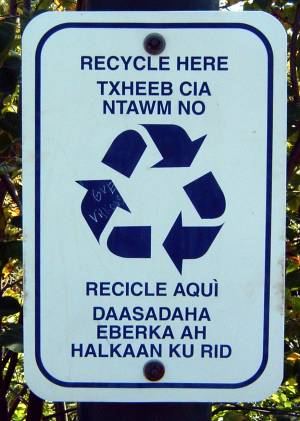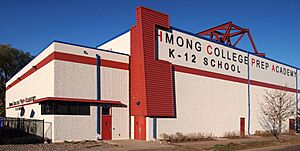History of the Hmong in Minneapolis–Saint Paul facts for kids
The Hmong people are a large group living in the Minneapolis–Saint Paul area in Minnesota. In 2010, about 66,000 Hmong people lived there. This makes it the biggest Hmong community in any city around the world! Many people see Minneapolis-St. Paul as a very important place for Hmong culture and community in the United States.
Contents
History
Many Hmong people came to Minnesota as refugees. They settled there because of help from groups called voluntary agencies, or VOLAGS. Minnesota had many of these groups ready to help Hmong families when they arrived.
In the early 1980s, the University of Minnesota and the Lao Family Community started programs to help Hmong people with farming. These programs helped them learn about agriculture.
In 2004, Randy Kelly, who was the mayor of St. Paul, visited Thailand. He went with a group of Hmong leaders and teachers. They wanted to learn about Hmong refugees living there.
Around 2006, more Hmong refugees from a place called Wat Tham Krabok in Thailand were expected to come to the Minneapolis-St. Paul area.
Demographics
Over time, fewer Hmong-American families are living in poverty. This is a positive change! In 2015, about 28.3% of Hmong-American homes were in poverty. This number has been going down in Minnesota too. In 1990, about 65% of Hmong people in Minnesota were in poverty. By 2011, this number had dropped to 31%.
Even without official numbers, it is believed that many Hmong people in the Twin Cities are millionaires. This shows how much the community has grown and succeeded.
By 2013, more than half of Hmong families in Minneapolis owned their own homes.
Commerce
Around 2013, Hmong businesses in the Minneapolis-St. Paul area made over $100 million in total sales. This shows how much they contribute to the local economy.
In 2011, many businesses owned by Hmong people were located along West University Avenue in St. Paul.
Two big shopping centers were created by Hmong businesspeople. Hmongtown Marketplace opened in 2004. It has over 200 shops and a Hmong food court. Hmong Village, a similar place, opened in 2009.
In 2012, McDonald's tried its first Hmong language advertisement in the United States. It was at a restaurant in Minneapolis.
Institutions
By 2013, there were about ten Hmong nonprofit organizations in St. Paul. These groups help the community in many ways.
The largest Hmong nonprofit group in Minnesota is the Hmong American Partnership (HAP). It is based in St. Paul. HAP was started in 1990 and helps the Hmong community with many services.
The Lao Family Community is the oldest Hmong organization. It is also based in St. Paul. This group helps organize big events like the New Year's Festival.
The Center for Hmong Arts and Talents (CHAT) is in St. Paul. It helps develop Hmong art and literature.
The Hmong Cultural Center is also located in St. Paul. It helps people learn about Hmong culture.
Politics
In 1991, Choua Lee became the first Hmong-American to be elected to public office in the area. She joined the school board of Saint Paul Public Schools. Neal Thao took her place in 1995 and served for seven years.
In 2000, Dr. Aly Xiong was the first Hmong-American to run for a seat in the Minnesota State Legislature.
The Hmong Veterans' Naturalization Act of 2000 helped more Hmong people become citizens. This gave them more power to vote and be involved in politics. In 2002, Cy Thao was elected to the Minnesota House of Representatives. Also, Mee Moua was elected to the Minnesota Senate.
In 2003, Kazoua Kong-Thao was elected to the St. Paul school board. She was the third Hmong-American to do so. In 2009, Mee Moua's sister, Vallay Moua Varro, was also elected to the St. Paul school board. This was the first time two Hmong officials served on the board at the same time. In 2013, Dai Thao became the first Hmong person elected to the St. Paul City Council.
Because of their large population, Hmong people have a lot of political influence in St. Paul. Since around 2000, politicians running for office often visit Hmong events to ask for their votes.
Media
There are two Hmong newspapers based in the Twin Cities area. They are called Hmong Today and Hmong Times.
Education
In 2000, about 24% of Hmong people in Minnesota had finished high school. About 8% had a college degree, and 1% had a master's degree or higher.
Many Hmong students attend schools in Minnesota. In 2000, there were 22,000 students of Hmong background in the state. Minneapolis Public Schools and St. Paul Public Schools have many Hmong students.
Minneapolis Public Schools has the Hmong International Academy. This school is for students from Pre-Kindergarten to 8th grade and focuses on the Hmong community. There are other schools that focus on Hmong culture too. The Hmong College Prep Academy is a K-12 charter school in Saint Paul. Hope Community Academy, a K-8 school in Saint Paul, also focuses on Hmong language and culture.
By 2011, more and more Hmong students were going to universities and colleges. Many Hmong student groups have started at these schools.
Culture and recreation
The Hmong New Year is a big celebration in the Minneapolis-St. Paul area. In 2013, the 38th annual Hmong New Year was held in St. Paul.
The 41st Annual Minnesota Hmong New Year was celebrated in 2020 at the River Center in Saint Paul, Minnesota.
Because of the farming programs in the 1980s, many Hmong people in Minnesota became interested in farming.
Pom Siab Hmoob (Gazing into the Heart of the Hmong) Theatre was formed in 1990. It is believed to be the world's first Hmong theater group. It is based in the Twin Cities. This group is now known as the Center for Hmong Arts and Talent (CHAT).
The movie Gran Torino, directed by Clint Eastwood, featured five Hmong Americans from Minnesota. The story was based on a neighborhood in Minneapolis. It was the first major U.S. film to show Hmong Americans.
Notable people
- Mee Moua (Minnesota state senator) - She was elected in 2002.
- Cy Thao (Minnesota state representative) - He was elected in 2002.
- Foung Hawj (Minnesota state senator) - He was elected in 2012.
- Bee Vang (actor in Gran Torino)
- Sunisa Lee (Gymnast, 2020 Olympic Women's All-Around champion).



